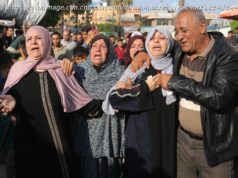Most of the 18 districts in Ghazni Province appear to be under Taliban control, with the exception of three districts with large populations of the Hazara ethnic minority.
KABUL, Afghanistan — More than 100 police officers and soldiers have been killed in the southeastern Afghan city of Ghazni in three days, a hospital official said on Sunday, as fighting continued in the strategic city, where Taliban insurgents have seized control of most neighborhoods.
The insurgents have also begun spreading into districts outside Ghazni city, two of which fell to them overnight, according to reports from local residents and Afghan officials.
Baz Mohammad Hemat, the director of the Ghazni Hospital, said by telephone that 113 bodies had been taken to the hospital, along with 142 wounded, most of them in uniform.
“We’re running out of hospital rooms; we are using corridors and available space everywhere,” he said. “Fighting is quite close to the hospital. The situation is really bad here. We’re receiving more and more wounded and dead every hour.”
The death toll appeared sure to rise, with numerous reports of bodies left unrecovered around the city. An additional 78 Afghan soldiers have been killed in fighting in other parts of the country over the past two days, officials said.
The fall of Ghazni would be the Taliban’s most important victory yet, as the city is on the main north-south highway, and its capture would effectively cut the capital and the north from the insurgents’ Pashtun homeland in the south.
“Heavy fighting is ongoing around the governor’s office, the Police Headquarters and the compound of the intelligence agency,” said Nasir Ahmad Faqiri, a member of the provincial council. “The forces in Ghazni have resisted well, but naturally they have fought so long. The reinforcements have not done anything effective, all they have done is establish a base for themselves.”
He added, “Bodies are lying around, they have decomposed, and no one is doing anything to evacuate them.”
The Afghan Minister of Public Health, Ferozuddin Feroz, said he had asked the International Committee of the Red Cross for “urgent help” in transporting the wounded out of Ghazni.
Taliban fighters there continued to take over guard posts the police had abandoned. At one, an insurgent shot a black dog three times with his AK-47. Asked why, he answered that it was a police guard dog that had alerted officers when the Taliban approached in the night.
At another post, a Ghazni resident, Ali Ahmad, said that he had seen the bodies of 12 police officers as he was leaving the city.
A reporter for The New York Times witnessed Taliban fighters overrunning the district of Khwaja Omari, immediately north of the city, late Friday and taking charge of government facilities and installations there. The insurgents left most civilians alone but knocked on the doors of homes in search of government officials.
Also late Friday, the Taliban overran Ajristan District, in west Ghazni Province, Zamin Ali Hedayat, the governor of the neighboring Malistan District, said by phone. That brought most of the 18 districts in Ghazni Province under the insurgents’ domination, with the exception of three districts with large populations of the Hazara ethnic minority. Other areas are predominantly Pashtun, as are most Taliban.
“The police chief of Ajristan, Obaidullah Khan, tried to flee the district yesterday,” Mr. Hedayat said. “On his way, the Taliban caught him with about 30 men. They beheaded Obaidullah Khan and killed the rest of the police.”
Col. Farid Ahmad Mashal, Ghazni’s police chief, said by telephone that reinforcements, including American troops, were beginning to clear the Taliban from the city. He said that more than 1,000 insurgents had attacked Ghazni, and that 500 had been killed.
“They dreamed of repeating the fall of Kunduz here, and we sent them to their graves with those dreams,” he said, referring to the northern city overrun briefly by the Taliban in 2015 and 2016 .
The government in Kabul and the army continued to insist that they were in full control of Ghazni. “The strategic locations in Ghazni city are in the control of government forces,” Mohammad Sharif Yaftali, chief of staff of Afghan Army, said at a news conference. “The governor’s office, prison, Police Headquarters and A. N. A. bases are under government control. The Taliban are settled in houses and shops of people inside the city.”
That being the case, the authorities said they were slowly moving ahead with “clearance operations” to remove the Taliban. Video posted on social media, however, showed insurgents strolling casually around the city. Numerous local residents confirmed that militants were commandeering homes to use as bases.
Accounts from residents leaving the city said the only areas still being held by the government were the governor’s office, police and intelligence agencies headquarters, an ancient fort called the Bala Hisar and a few other government facilities.
The United States military has an estimated 14,000 troops in Afghanistan, mostly advisers and support forces, but also Special Operations troops. Unlike most of the other 40 members of the international military coalition in Afghanistan, the Americans are allowed to participate in military operations, and they have done so on several occasions when Afghan forces ran into severe difficulty. In addition, the United States frequently provides air support for the Afghans.
In addition to taking the Khwaja Omari district north of Ghazni city, the insurgents took over the large community of Nawabad, to the northwest, on Friday. Saleem Shah, a money changer who lives in Nawabad and was reached by telephone, said the insurgents circulated, hoisting their white flags and telling residents they would not be harmed. Many residents with multistory homes, however, were asked to leave so the Taliban could use their roofs to take position for fighting.
Taliban insurgents said they had amassed forces from several provinces for the attack on Ghazni, the fourth time they have tried to overrun a provincial capital. Despite the large number of insurgents fighting in Ghazni, the Taliban also mounted deadly attacks in two other parts of the country on Friday and Saturday.
In the northern province of Faryab, a sustained assault over several weeks on an Afghan National Army base in the Ghormusch District ended on Saturday with the deaths of 32 Afghan security forces, 17 army soldiers and 15 border officers, according to First Lt. Shah Fahim, the platoon commander whose unit was defending the base.
Home
United States
USA — Political Over 100 Officers and Soldiers Killed in Crucial Afghan City in 3...






